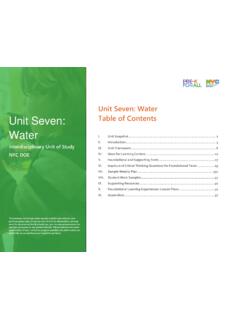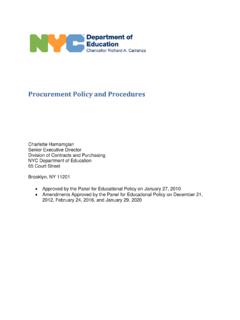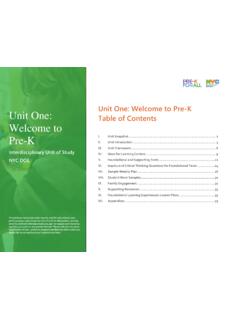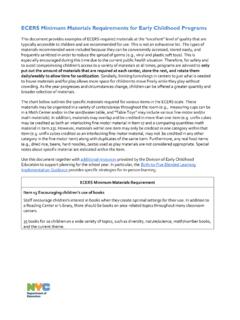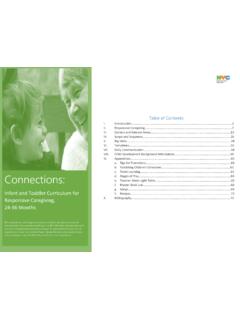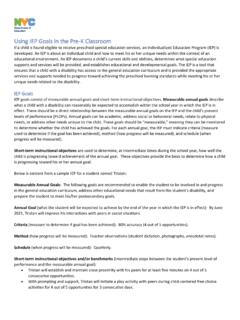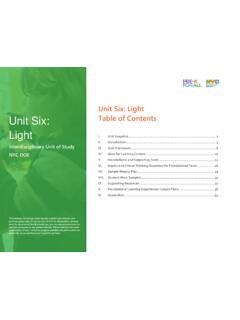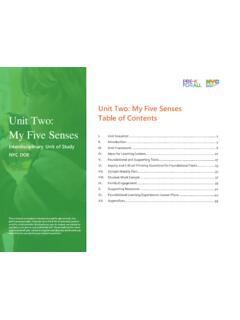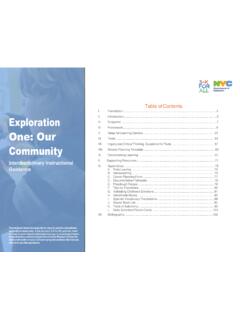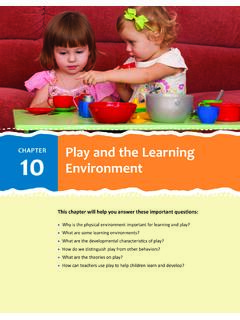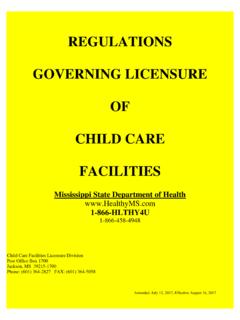Transcription of The Early Childhood Environment Rating Scale - Revised ...
1 The Early Childhood Environment Rating Scale - RevisedWebinar SeriesECERS-R 101 ECERS-R Webinar Series TitleDescriptionECERS-R 101 Why theDECE uses the ECERS-R tool What the ECERS-R tool measures, broadly What to expect before, during,and after an ECERS-R assessment What resources are available to support youECERS-R 102 This webinar provides a deep dive into the Space and Furnishings 103 This webinar provides a deep dive into the Personal Care RoutinessubscaleECERS-R 104 This webinar provides a deep dive into the Language-Reasoningand Interaction 105 This webinar provides a deep dive into the 106 This webinar provides a deep dive into the Program StructuresubscaleECERS-R 107 How to read and interpret your ECERS-R report How to use ECERS-Rdata andrecommendations toinform pre-K program goalsThe PQS and the Framework for Great SchoolsThe Framework for Great SchoolsThe Pre-K for All Program Quality Standards (PQS)
2 Are grounded in the DOE s Framework for Great Schools Describe the key practices that support children in gaining the knowledge and skills outlined in the New York State Prekindergarten Foundation for the Common Core (PKFCC) Define the NYCDOE s vision for high-quality Pre-K for All programsThe DOE uses the Early Childhood Rating Scale (ECERS-R) and the Classroom Assessment Scoring System (CLASS) to understand pre-K program qualityEvery program receives an ECERS-R and CLASS assessment at leastonce every three yearsThe DOE uses the ECERS-R tool as a way to look consistentlyat pre-K learning environments across the city Developed by the University of North Carolina as a way to measure a range of the factors that impact children s experiences in pre-K Research shows that the ECERS-R tool is a valid and reliable measure to examine the learning Environment Some studies show that higher ECERS-R scores are associated with increased student outcomes The DECE uses the ECERS-R tool to understand key characteristics of the learning environments that children have access to in pre-K programs across the city.
3 In all settingsThe Six ECERS-R SubscalesIt is the average of all of these factors that relate to children s outcomesSpace & FurnishingsPersonal Care RoutinesLanguage-ReasoningActivitiesInte ractionProgram Structure1. Indoor space2. Furniture for care, play, and learning3. Furnishings for relaxation and comfort4. Room arrangement for for privacy6. Child-related display7. Space for gross motor play8. Gross motor equipment9. Greeting/departing10. Meals/snacks11. Nap/rest12. Toileting/diapering13. Health practices14. Safety practices15. Booksand pictures16. Encouraging children to communicate17. Using language to develop reasoning skills18. Informal use of language19. Fine motor20. Art21. Music/movement22 . B l o c k s23. play25. Nature/science26. Math/number27. Use of computers28. Promoting acceptance of diversity29.
4 Supervisionof gross motor activities30. General sup ervision of children31. Discipline32. Staff-child interactions33. Interactions among children34. Schedule35. Free play36. Group time37. Provisions for children with disabilitiesWebinar: ECERS-R102 Webinar: ECERS-R 103 Webinar:ECERS-R 104 Webinar:ECERS-R 105 Webinar:ECERS-R 104 Webinar:ECERS-R 106 Why does the Division of Early Childhood Education conduct assessments? To understand the experiences of children in all Pre-K for All programs ECERS-R and CLASS are rubrics that give us a way to quantify some of the things that we think are important for children Assessments with tools and impartial evaluators allow us to look at program quality consistently across programs Scores give us an understanding of each program s quality on some program quality standardsWhat does the Division of Early Childhood Education do with the results?
5 Understand quality of the city s pre-KUnderstand individual pre-K program qualityProvide information to communities Citywide results help the DOE understand overall portfolio strengths, challenges, and quality change over time Results help the DOE understand what kind of on-site support each program needs Results help the DOE understand program quality for contract renewal decisions and other accountability processes ECERS-R and CLASS are 2 of 3 sources of information in the Pre-K Program Quality SnapshotsWho conducts ECERS-R and CLASS assessments? DOE staff members called Program Evaluators Evaluators must pass a reliability test on a yearly basis to maintain certification They receive additional training on data collection, report writing, and addressing bias Participate in ongoing training Tea m-wide, over 5 languages are representedBefore the Assessment Day You will be notified that your program has been selected for a ECERS-R assessment during the school year, from In most cases, a DOE ECERS-R evaluator will contact you by email you at least two weeks in advance to schedule an assessment date Program leaders confirm that the proposed date reflects a typical day of school.
6 Or let the evaluator know if that is not the case Your evaluator will send you a reminder email before the assessment date to confirm classroom schedules and arrival timeOn the Day of Assessment Your evaluator will arrive about 30 minutes before the start of your program s Pre-K for All hours Evaluators randomly select one of the pre-K classes in which to observe Evaluators stay with that class throughout the day including lunch, recess, and any specials The observation will take place for 3 to hours Evaluators meet with the lead teacher for about 30 minutes at the conclusion of the observation to ask about any items that were not observed Program leaders receive a follow-up survey to give feedback on the process after the assessment takes placeProgram leaders receive an ECERS-R report within about 6 weeks of the assessmentDOE ECERS-R Modifications The DOE has made some changes to the way we use ECERS-R to make it a better fit for NYC ECERS-R modifications are reconsidered and made before each school year begins The Environment Rating Scales Institutealso periodically makes changes to the ECERS-R tool All of the changes are outlined in the NYC DOE DECE Additional Notes for the ECERS-R Throughout this webinar series.
7 Changes will be marked with red text. Additional ECERS-R Resources The All About the ECERS-R book ECERS-R spiral-bound Scale (if you have one) To request a copy, email your site ID/DBN to Webinar Series TitleDescriptionECERS-R 101 Why theDECE uses the ECERS-R tool What the ECERS-R tool measures, broadly What to expect before, during,and after an ECERS-R assessment What resources are available to support youECERS-R 102 This webinar provides a deep dive into the Space and Furnishings 103 This webinar provides a deep dive into the Personal Care RoutinessubscaleECERS-R 104 This webinar provides a deep dive into the Language-Reasoningand Interaction 105 This webinar provides a deep dive into the 106 This webinar provides a deep dive into the Program StructuresubscaleECERS-R 107 How to read and interpret your ECERS-R report How to use ECERS-Rdata andrecommendations toinform pre-K program goalsThank you!
8 For any further questions to.
